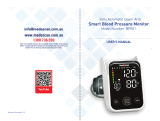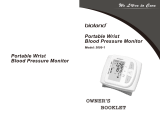
strument on a child.
In cases of irregular heartbeat (Arrhythmia), measurements made with this instrument should•
only be evaluated after consultation with your doctor.
Familiarize yourself with the section titled "Important Information on Blood Pressure and its•
Measurement". It contains important information on the dynamics of blood pressure readings
and will help you to obtain the best results.
NOTE! This device contains sensitive electronic components. Avoid strong electrical or electro-
magnetic fields in the direct vicinity of the device (e.g. mobile telephones, microwave ovens) during
use. These can lead to erratic results.
Do not attempt to service or repair this device yourself. Should a malfunction occur, refer to page
23 of this booklet for service information.
Warnings and Precautions
Warning: The device contains sensitive electronic components. Avoid strong electrical or elec-
tromagnetic fields in the direct vicinity of the device (e.g. mobile telephones, microwave ovens).
These can lead to temporary impairment of the measuring accuracy.
Warning: Use of this instrument on patients under dialysis therapy or on anticoagulant, an-
tiplatelets, or steroids could cause internal bleeding.
Warning: Do not use cuffs, AC adapters or batteries other than those included with this product
or replacement parts supplied by the manufacturer.
Warning: This system may fail to yield specified measurement accuracy if operated or stored in
temperature or humidity conditions outside the limits stated in the specifications section of this manual.
Warning: This product may contain a chemical known to the state of California to cause cancer,
birth defects, or other reproductive harm.
Caution: To avoid any possibility of accidental strangulation, keep this unit away from children
and do not drape tubing around your neck.
Caution: The standard material used for the bladder and tubing is latex-free.
Attention: Self-measurement means control, not diagnosis or treatment. Unusual values must
always be discussed with your doctor. Under no circumstances should you alter the dosages of any
drugs prescribed by your doctor.
Attention: The pulse display is not suitable for checking the frequency of heart pacemakers!
Attention: In cases of irregular heartbeat, measurements made with this instrument should only
be evaluated after consultation with your doctor.
Note: To obtain the greatest accuracy from your blood pressure instrument, it is recommended
that the instrument be used within a temperature range of 50°F (10°C) to 104°F (40°C), with a rela-
tive humidity range of 15-90% (non-condensing).
2. Important Information on Blood Pressure and its Measurement
2.1. How does high or low blood pressure arise?
Your level of blood pressure is determined in the circulatory center of the brain and adjusts to a
variety of situations through feedback from the nervous system. To adjust blood pressure, the
strength and speed of the heart (Pulse), as well as the width of circulatory blood vessels is altered.
Blood vessel width is controlled by fine muscles in the blood vessel walls.
Your level of arterial blood pressure changes periodically during heart activity: During the “blood
ejection” (Systole) the value is highest (systolic blood pressure value). At the end of the heart’s “rest



















